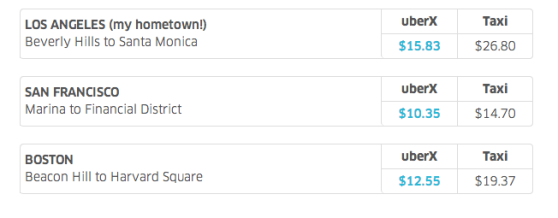Amid controversy over the death of 6-year-old girl and surge pricing during peak hours, Uber is attempting to win back your heart in a time-tested way — by cutting its prices.
Uber announced today that it is dropping prices across the country for UberX, the lower cost alternative to its black car service.
“What if Uber was actually the cheapest ride in every Uber city?” Uber CEO Travis Kalanick said in a blog post. “Some have asked how we do it. How can we keep getting prices down over time? More cars and drivers mean better coverage and lower pickup times. Lower pickup times mean better economics for drivers, and thus more drivers and cars.”
 The company is cutting UberX prices in 16 out of its 24 markets. The new fares are now up to 34 percent lower in Chicago, San Francisco, Seattle, Los Angeles, Phoenix, and Orange County. Minneapolis, Atlanta, Sacramento, Tucson, Denver, Dallas, Baltimore, Charlotte, and Nashville also receive price cuts.
The company is cutting UberX prices in 16 out of its 24 markets. The new fares are now up to 34 percent lower in Chicago, San Francisco, Seattle, Los Angeles, Phoenix, and Orange County. Minneapolis, Atlanta, Sacramento, Tucson, Denver, Dallas, Baltimore, Charlotte, and Nashville also receive price cuts.
Kalanick claims that on average, UberX is 26 percent cheaper than a taxi. He adds that the new prices also undercut competitive ridesharing services such as Lyft and Sidecar. He goes so far as to say that with the fare-splitting feature, it could be cheaper than the bus.
However Lyft CEO John Zimmer disagrees.
“Uber prices will still be higher,” Zimmer told VentureBeat. “What does a price decrease mean when there is 8x surge pricing? It’s classic bait and switch and consumers see through that.”
Uber is a popular app for hailing cars to you on-demand. It started out as luxury black car service and has since added SUV, regular taxis, and UberX, where drivers pick you up in regular cars. Kalanick built Uber’s brand around the ideas of professionalism, reliability, and quality. He is also known for being fearsomely competitive and doing whatever it takes to overcome regulatory challenges and edge out competitors.
But over the past couple months, Uber riders began complaining that the quality of the service has slipped, wait times are longer, and price spikes during busy times.
Kalanick responded earlier this week by saying that surge pricing is a method of finding the “market price” and necessary for balancing supply and demand. Hotel rooms or airline flights have dynamic pricing and people accept it, so why shouldn’t ground transportation?
“The price must go up for these rides to happen,” Kalanick said in a video interview with the Wall Street Journal. “If surge pricing doesn’t happen, there is no availability. You can’t get a ride.”
Whether or not it makes economic sense, no customer likes paying more (or feeling like they are paying more) for a ride.
Uber has some damage-control to do. And what better way to keep customers than by becoming the cheapest option in town?
This is the latest in a series of cuts. Uber lowered prices in San Francisco, Los Angeles, San Diego, and Washington D.C. last year shortly after raising $258 million in financing. The “ridesharing wars” between Uber, Lyft, Sidecar, Flywheel, and traditional cabs are heating up, and cost is a major battleground.
VentureBeat's mission is to be a digital town square for technical decision-makers to gain knowledge about transformative enterprise technology and transact. Learn More

